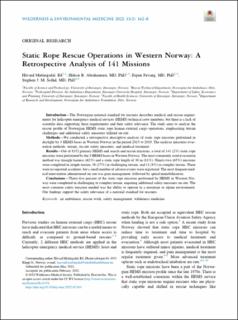| dc.contributor.author | Mattingsdal, Håvard | |
| dc.contributor.author | Abrahamsen, Håkon Bjorheim | |
| dc.contributor.author | Fevang, Espen | |
| dc.contributor.author | Sollid, Stephen J. M. | |
| dc.date.accessioned | 2023-01-20T10:09:29Z | |
| dc.date.available | 2023-01-20T10:09:29Z | |
| dc.date.created | 2022-04-09T17:27:33Z | |
| dc.date.issued | 2022 | |
| dc.identifier.citation | Mattingsdal, H., Abrahamsen, H. B., Fevang, E., & Sollid, S. J. (2022). Static rope rescue operations in western Norway: a retrospective analysis of 141 missions. Wilderness & Environmental Medicine. | en_US |
| dc.identifier.issn | 1080-6032 | |
| dc.identifier.uri | https://hdl.handle.net/11250/3044906 | |
| dc.description.abstract | Introduction
The Norwegian national standard for rescuers describes medical and rescue requirements for helicopter emergency medical services (HEMS) technical crew members, but there is a lack of scientific data supporting these requirements and their safety relevance. The study aims to analyze the rescue profile of Norwegian HEMS static rope human external cargo operations, emphasizing terrain challenges and additional safety measures utilized on-site.
Methods
We conducted a retrospective descriptive analysis of static rope missions performed in daylight by 3 HEMS bases in Western Norway in the period 2015 to 2019. The analysis measures evacuation methods, terrain, on-site safety measures, and medical treatment.
Results
Out of 8352 primary HEMS and search and rescue missions, a total of 141 (2%) static rope missions were performed by the 3 HEMS bases in Western Norway. The most commonly used evacuation method was triangle harness (62%) and a static rope length of 30 m (81%). Ninety-two (65%) missions were completed in simple terrain, 38 (27%) in challenging terrain, and 11 (8%) in complex terrain. There were no reported accidents, but a small number of adverse events were registered. The most frequent medical intervention administered on-site was pain management, followed by spinal immobilization.
Conclusions
Thirty-five percent of the static rope missions performed by HEMS in Western Norway were completed in challenging or complex terrain, requiring additional safety measures on-site. The most common safety measure needed was the ability to operate in a mountain or alpine environment. Our findings support the safety relevance of a national standard for rescuers. | en_US |
| dc.language.iso | eng | en_US |
| dc.publisher | Elsevier | en_US |
| dc.rights | Navngivelse 4.0 Internasjonal | * |
| dc.rights.uri | http://creativecommons.org/licenses/by/4.0/deed.no | * |
| dc.title | Static Rope Rescue Operations in Western Norway: A Retrospective Analysis of 141 Missions | en_US |
| dc.title.alternative | Static Rope Rescue Operations in Western Norway: A Retrospective Analysis of 141 Missions | en_US |
| dc.type | Peer reviewed | en_US |
| dc.type | Journal article | en_US |
| dc.description.version | publishedVersion | en_US |
| dc.rights.holder | The author | en_US |
| dc.subject.nsi | VDP::Medisinske Fag: 700 | en_US |
| dc.source.journal | Wilderness & environmental medicine (Print) | en_US |
| dc.identifier.doi | 10.1016/j.wem.2022.02.003 | |
| dc.identifier.cristin | 2016425 | |
| cristin.ispublished | true | |
| cristin.fulltext | original | |
| cristin.qualitycode | 1 | |

